Bulletin – September 2017 Australian Economy The Transmission of Monetary Policy: How Does It Work?
- Download 414KB
Abstract
The transmission of monetary policy refers to how changes to the cash rate affect economic activity and inflation. This article outlines the stages of transmission and the channels through which it occurs. The effects of monetary policy are hard to quantify, though the housing market seems particularly important to the transmission process in Australia. A lower cash rate stimulates household spending and housing investment, partly through increasing the wealth and cash flow of households. A lower cash rate also tends to result in a depreciation of the exchange rate, leading to higher net exports and imported inflation.
The Reserve Bank conducts monetary policy in Australia to achieve its objectives of price stability, full employment, and the economic prosperity and welfare of the Australian people. In support of this, the Bank has an inflation target that seeks to keep inflation between 2 and 3 per cent, on average, over time. The cash rate is the ‘instrument’ used to influence inflation in order to achieve this flexible medium-term target.[1] The transmission of monetary policy refers to how a change to the cash rate affects the interest rates that households and businesses face and, in turn, economic activity, employment and inflation. Understanding this transmission process helps the Reserve Bank assess current and future economic developments, and helps the Reserve Bank Board decide on the setting of monetary policy. It is also a helpful framework for describing to a wider audience how changes to monetary policy flow through to economic activity, employment and inflation.
A simple picture of the transmission of monetary policy is shown in Figure 1. When the Reserve Bank lowers the cash rate, this causes other interest rates in the economy to fall. Lower interest rates stimulate spending. Businesses respond to this by increasing how much they produce, leading to an increase in economic activity and employment. If the increase in demand is strong enough it can push up prices, and lead to higher inflation.
While this is a simple textbook description, the effects of monetary policy can be also seen in practice. Some estimates from work at the Reserve Bank suggest that lowering the cash rate by 100 basis points leads to economic activity, as measured by GDP, being ½ to ¾ percentage point higher than it otherwise would be over the course of two years. Inflation typically rises by a bit less than ¼ percentage point per year over two to three years.[2] More generally, estimates suggest that it takes between one and two years for changes in the cash rate to have their maximum effect on economic activity and inflation.
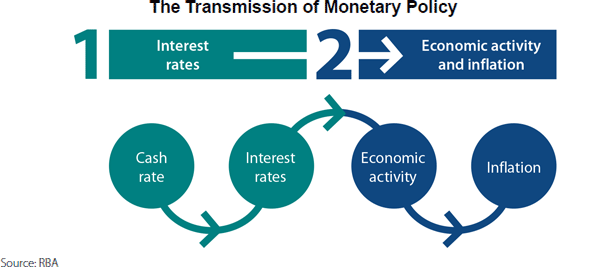
The transmission of monetary policy can be simplified into two stages:
- Changes to the cash rate affect other interest rates in the economy.
- Changes in these interest rates affect economic activity and inflation.
This article outlines these two stages and discusses the main channels through which monetary policy affects the Australian economy.[3] It focuses on the basic effects of a reduction in interest rates (an ‘easing’ of monetary policy).[4] An increase in interest rates (a‘tightening’ of monetary policy) has the opposite effect. In reality, these effects are complex, and can vary over time, so it is not possible to know exactly how long they will take to play out, or exactly how large they will be. The size of the effects will depend on factors such as whether financial markets expected the change and where they expect interest rates will be in future.
The transmission of monetary policy is also affected by inflation expectations. Households' and businesses' expectations about future inflation can affect their current behaviour.[5] For example, if workers expect prices to rise in the future, they might ask for larger wage increases to maintain their purchasing power. Similarly, if businesses expect prices in the economy to rise, they might raise their prices now, depending on the outlook for demand and competitive conditions in the industry. In both of these examples, higher expectations for inflation can lead to higher actual inflation.
So that higher expected inflation does not lead to ever-higher actual inflation, it is important for the central bank to have a credible monetary policy framework. This can help anchor inflation expectations, which should increase the confidence of households and businesses in making saving, spending and investment decisions because it reduces uncertainty about the economy.
The First Stage of Monetary Policy Transmission
The first stage of monetary policy transmission refers to how changes to the cash rate affect other interest rates in the economy. The cash rate is the market interest rate for overnight loans between financial institutions. It serves as a benchmark for interest rates at which funds can be lent or borrowed in financial markets, including for different sources of bank funding, such as wholesale debt and deposits. Through its effect on the funding costs of financial institutions, the cash rate has a strong influence over the lending and deposit rates that households and businesses face. As a result, the cash rate and other interest rates have moved in broadly similar ways since at least the early 1990s (Graph 1).
The extent to which changes in the cash rate flow through to other interest rates is often referred to as ‘interest rate pass-through’. While the cash rate acts as an anchor for other interest rates, it is not the only determinant. Other factors such as conditions in financial markets, changes in competition, and risks associated with different types of loans also influence interest rates. As a result, the degree of interest rate pass-through can vary over time. For instance, since the global financial crisis, banks' funding costs have risen relative to the cash rate because of a reassessment of risk in financial markets and greater competition among banks for different sources of funding (Atkin and Cheung 2017). Over the same period, banks have increased their lending rates relative to the cash rate (Graph 2).[6]
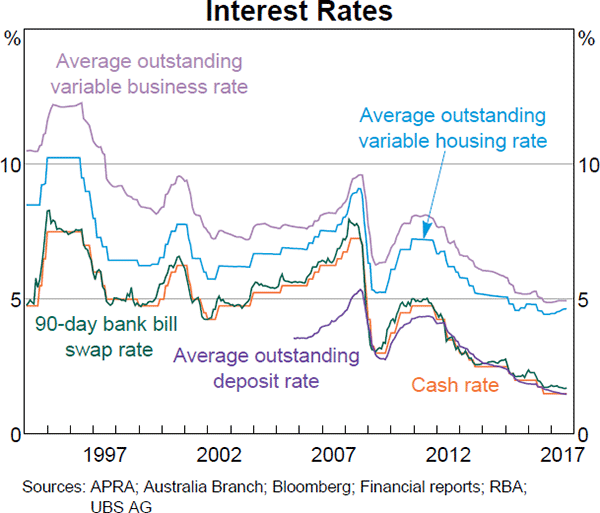
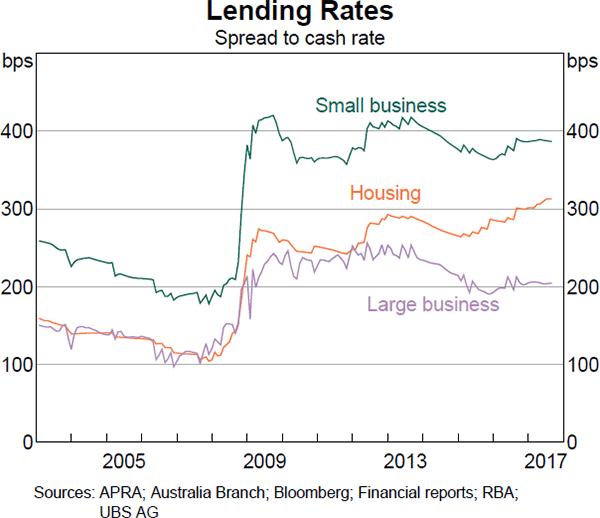
The speed of interest rate pass-through to households and businesses depends on whether loans and deposits have variable or fixed interest rates. Loans and deposits that have variable interest rates typically respond very quickly to changes in the cash rate. In Australia, variable-rate loans account for around four-fifths of housing loans and roughly two-thirds of business loans. As a result, a large share of loans can be influenced by a change in the cash rate relatively quickly. In contrast, interest rates on existing fixed-rate loans are not affected by a change in the cash rate. Interest rates on new fixed-rate loans depend on the expected path of interest rates. As a result, an anticipated change in the cash rate would not typically be passed through to new fixed-rate loans.
While interest rate pass-through varies over time, this does not necessarily mean that monetary policy is any more or less effective in influencing the economy. The Reserve Bank Board takes developments in funding costs and lending rates into account when determining the appropriate setting of the cash rate (Lowe 2012). The Board aims to ensure that interest rates faced by households and businesses are consistent with the desired stance of monetary policy. For example, if the Board expects that a given reduction in the cash rate will not be matched by an equivalent reduction in interest rates, then it can opt for a larger reduction in the cash rate as required to achieve the desired monetary policy setting.
The Second Stage of Monetary Policy Transmission
The second stage of transmission refers to how changes to interest rates influence economic activity, employment and inflation. This occurs through a range of different channels (Figure 2). The main differences between the channels are in how interest rates influence economic activity.[7] In contrast, the links between economic activity and inflation are basically the same for all the channels.
The saving and investment channel
Interest rates influence economic activity by changing the incentives for households and businesses to save rather than consume or invest:
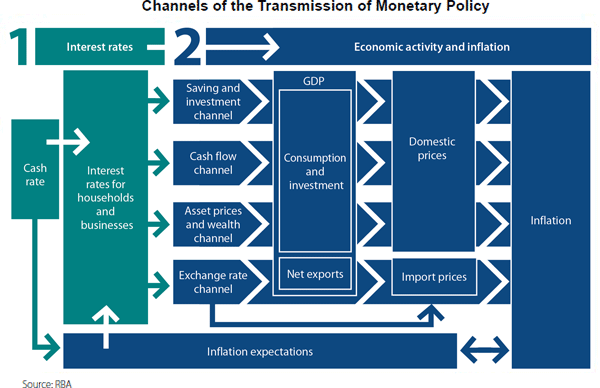
- A reduction in interest rates reduces the incentives for households to save and can encourage them to borrow. Because of this, there are greater incentives for households to spend now rather than later. In particular, it can stimulate spending on durable goods, such as cars and household appliances, and housing. As a result, lower interest rates should be associated with higher household consumption and housing investment.
- Similarly, lower interest rates encourage businesses to borrow and increase their spending on investment (in capital assets like new equipment or buildings). As interest rates fall, the cost of borrowing declines, leading to higher expected returns on investment projects. This can help to justify going ahead with these projects. Overall, lower interest rates should be associated with an increase in business investment.
In modern macroeconomic textbooks this channel is known as the ‘inter-temporal substitution’ channel, as households and businesses substitute between spending now and in the future. It is a key channel of monetary transmission in many modern macroeconomic models. Despite this, there is mixed evidence as to whether a strong relationship between lower interest rates and higher consumption growth actually exists. Lawson and Rees (2008) find that housing investment and business investment in machinery and equipment are actually the most sensitive components of GDP expenditure to changes in monetary policy. But this research does not provide specific evidence for any particular channel of monetary transmission.
The cash flow channel
Lower interest rates influence the spending decisions of households and businesses by reducing the amount of interest they pay on debt and the interest they receive on deposits. This affects how much disposable income (or ‘cash flow’) they have available to spend. This is commonly referred to as the cash flow channel of monetary policy.[8] The importance of this channel is often emphasised by policymakers and the news media.
The cash flow channel works in opposite directions for ‘borrowers’ (those with more variable-rate debt than deposits) and ‘lenders’ (those with more variable-rate deposits than debt).
- For borrowers, lower lending rates can reduce the repayments they must make, assuming they have variable-rate debt. This can result in higher disposable income, and households may choose to spend more, particularly if income was previously a constraint on their spending.
- For lenders, lower rates on deposits (or other interest-earning assets such as bonds) reduce their interest income; facing a reduction in disposable income, they may choose to cut their spending.
Recent research points to evidence of the cash flow channel for both borrowing and lending households (La Cava, Hughson and Kaplan 2016). However, the cash flow channel is stronger for borrowers for two reasons. First, the Australian household sector as a whole is a net debtor. The average borrower holds two to three times as much variable-rate debt as the average lender holds in interest-earning assets (Graph 3). As a result, lower interest rates lead to higher cash flow in the aggregate economy.
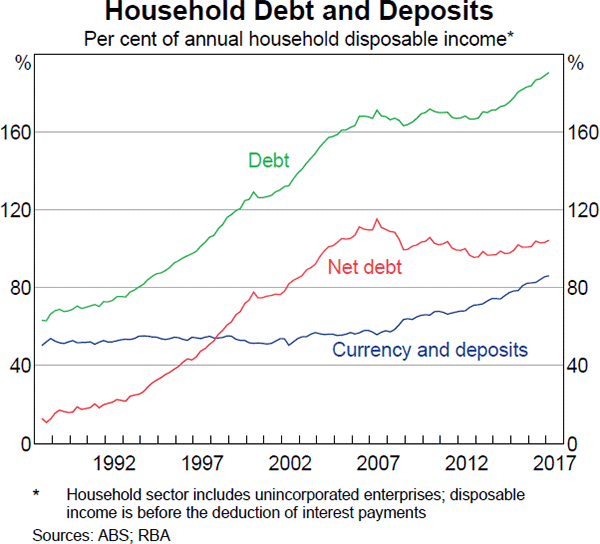
Second, the spending of borrowers is more sensitive to changes in cash flow than the spending of lenders. This is because borrowers are more likely than lenders to be constrained by the amount of cash they have available. Taking the effects on borrowers and lenders together, one set of estimates suggests that lowering the cash rate by 100 basis points increases total household disposable income by around 0.9 per cent, which, in turn, increases aggregate household spending by about 0.2 per cent through the cash flow channel (Hughson et al 2016).
The asset prices and wealth channel
This channel recognises that asset prices and wealth are key determinants of household and business spending. Fluctuations in asset prices not only affect households' and businesses' overall wealth (the wealth channel), but also their borrowing capacity (the balance sheet channel).[9]
- The wealth channel: A reduction in interest rates stimulates demand for assets, such as equities and housing, raising the prices of these assets. This occurs because the reduction in interest rates increases the present discounted value of the asset's future income flows. An increase in asset prices increases the wealth of households and businesses. This can lead to more spending for households and businesses as they generally spend some share of any increase in their wealth; this is often referred to as the wealth effect.
- The balance sheet channel: A reduction in interest rates can increase the borrowing capacity of households and businesses. This is because lower interest rates are associated with higher asset prices. In turn, higher asset prices increase the equity (or collateral) of existing assets that a bank can lend against. As a result, borrowers with existing assets may be able to borrow more, which can lead to more spending, particularly if they were previously constrained by how much they could borrow.[10]
A key difference between the wealth channel and balance sheet channel is that changes in wealth potentially affect all households and businesses, while changes in borrowing capacity mainly affect the spending of those that are currently constrained by how much they can borrow. However, this does not imply that the balance sheet channel is weaker than the wealth channel; the spending of constrained borrowers is typically very sensitive to changes in asset prices.
A range of Australian studies have looked at this channel for household spending. There is general consensus that lower interest rates lead to higher asset prices, and that higher wealth is associated with more household spending. In particular, several studies find evidence that higher housing prices are associated with more spending (La Cava, Windsor and Hansen 2015; Windsor, Finlay and Jääskelä 2015). Younger households also seem to be more sensitive than older households to changes in housing wealth, which suggests that being constrained by how much you can borrow matters for spending (Windsor, Finlay and Jääskelä 2015). This result is more consistent with the balance sheet channel than the wealth channel, and highlights how difficult it can be to disentangle the channels in practice.
There is also extensive evidence from overseas that businesses balance sheets matter for the transmission of monetary policy, and there is some Australian evidence too. For example, Jacobs and Rayner (2012) show that an unexpected decrease in the cash rate results in fewer businesses reporting difficulties obtaining bank funding. La Cava (2005) finds that cash flow matters to business investment decisions, suggesting that monetary policy can also affect business investment through this channel.
The exchange rate channel
Interest rates influence the exchange rate, which can have a notable effect on economic activity and inflation in a small open economy such as Australia. Typically this channel is stronger for sectors that are export-oriented or exposed to competition from imported goods and services. The exchange rate also has a direct effect on inflation.
- A reduction in the cash rate lowers interest rates in Australia relative to those in the rest of the world. This reduces the returns on Australian assets (relative to foreign assets), which can result in lower demand for Australian dollars as investors shift their funds into foreign assets. As a result, a reduction in the cash rate should be associated with a depreciation in the exchange rate.
- A depreciation in the exchange rate increases the competitiveness of domestic producers in foreign markets by reducing the prices of their goods and services compared with foreign competitors. This can lead to a rise in export volumes.[11] A depreciation in the exchange rate can also flow through to higher demand for domestically produced goods and services as Australians substitute away from more expensive imports. This can lead to lower import volumes. As a result, lower interest rates should be associated with an increase in export volumes and a reduction in import volumes (or higher net exports).
- A depreciation in the exchange rate has a direct effect on inflation through higher import prices. For example, a depreciation of the Australian dollar typically raises the price of imported consumer goods, such as cars, computers and TVs. It can also indirectly increase inflation as it may allow domestic firms that produce similar items to increase their margins. An increase in import prices also raises the cost of imported inputs, such as imported capital and intermediate goods, used in production. Depending on how much competition there is in different sectors, businesses may pass on these higher costs to retail prices, which can indirectly feed through to higher inflation. As a result, a reduction in the cash rate should be associated with higher imported inflation.
One set of empirical estimates for Australia suggests that the effect of interest rates on the exchange rate is relatively small. An unexpected 25 basis point decrease in the cash rate is estimated to lead to a ¼ to ½ per cent depreciation of the exchange rate.[12]
There is also evidence that changes in the exchange rate affect exports and imports. Estimates suggest that a 10 per cent depreciation lifts export volumes by 3 per cent while reducing import volumes by 4 per cent within two years. The resulting increase in net exports leads to higher economic activity.[13]
With regard to the direct effect of the exchange rate on inflation, estimates suggest that a depreciation of the exchange rate leads to a large and immediate increase in import prices.
However, the subsequent effect of higher import prices on the final prices that households pay is smaller and occurs more slowly.[14]
Footnotes
At the time of writing, the authors were in the Public Access & Education section and Economic Analysis Department, respectively. This article has an associated ‘Explainer’ as part of the Reserve Bank's education resources, which is specifically targeted at senior high school students. [*]
The implementation of monetary policy and how the Reserve Bank maintains the cash rate at its target level is discussed in Baker and Jacobs (2010). [1]
These estimates come from a macroeconomic model based on Rees, Smith and Hall (2016). Brischetto and Voss (1999), Dungey and Pagan (2009) and Berkelmans (2005) also find that unexpected changes to the cash rate affect output and inflation. [2]
The perspectives on the transmission of monetary policy in this article are similar to those internationally. For more discussion of the transmission of monetary policy, see Mishkin (1996) and George et al (1999). [3]
The ‘stance of monetary policy’ (the level of the cash rate relative to a ‘neutral’ interest rate) is also important. The neutral rate can be thought of as the rate required to bring about full employment and stable inflation over the medium term. When the cash rate is below the neutral rate, then monetary policy is exerting an expansionary influence on the economy, and if the cash rate is above the neutral rate, then monetary policy is exerting a contractionary influence on the economy. While the focus is often on the change in the cash rate, it is also important to understand how far the cash rate is from the neutral rate. However, because the neutral rate cannot be directly observed this is difficult in practice. For more information, see McCririck and Rees (2017). [4]
For more information on measures of inflation expectations in Australia, see Moore (2016). [5]
For more information on developments in banks' funding costs and lending rates, see Cheung (2017). [6]
One exception is the exchange rate channel where there is a direct effect on inflation. [7]
The cash flow channel is described here in terms of the direct effect of interest rate changes on income from interest-sensitive assets and debt. There is research indicating that interest rate changes can also have indirect cash flow effects by influencing other sources of income, such as wages. For example, see Auclert (2017). [8]
The balance sheet and cash flow channels of monetary policy are sometimes referred to under a broader ‘credit channel’ of monetary policy. For example, see Mishkin (1996). [9]
This section focuses on the balance sheets of borrowers. But changes in interest rates can also affect the balance sheets of lending institutions, such as banks, affecting the supply of credit and economic activity (‘bank lending channel’). There are currently few Australian studies that have explored these bank lending channels. The limited evidence suggests that these channels are not particularly strong (Suzuki 2004). [10]
If domestic producers are unable to fully satisfy the higher demand, they may also increase their prices. [11]
These estimates come from a macroeconomic model based on Rees, Smith and Hall (2016). [12]
For more information on the sensitivity of trade to the exchange rate, see Cole and Nightingale (2016). [13]
The timing and extent of this effect is uncertain. The effect of the exchange rate change on retail prices may depend on the currency in which imports are invoiced, may be absorbed in importers' or retailers' margins in response to competitive pressures, or may be deferred where importers or retailers have contracted prices in advance. Importantly, the currency in which imports are invoiced can affect the transmission process. In particular, Australian dollar invoicing reduces the effect of exchange rate movements on importers' costs, and so the prices charged to consumers are generally less responsive to changes in the exchange rate. For more information on the exchange rate and pass-through to consumer prices, see Chung, Kohler and Lewis (2011) and Gillitzer and Moore (2016). [14]
References
Atkin T and B Cheung (2017), ‘How Have Australian Banks Responded to Tighter Capital and Liquidity Requirements?’, RBA Bulletin, June, pp 41–50.
Auclert A (2017), ‘Monetary Policy and the Redistribution Channel’, NBER (National Bureau of Economic Research) Working Papers 23451.
Baker A and D Jacobs (2010), ‘Domestic Market Operations and Liquidity Forecasting’, RBA Bulletin, December, pp 37–43.
Berkelmans L (2005), ‘Credit and Monetary Policy: An Australian SVAR’, RBA Research Discussion Paper No 06.
Brischetto A and G Voss (1999), ‘A Structural Vector Autoregression Model of Monetary Policy in Australia’, RBA Research Discussion Paper No 11.
Cheung B (2017), ‘Developments in Banks' Funding Costs and Lending Rates’, RBA Bulletin, March, pp 45–50.
Chung E, M Kohler and C Lewis (2011), ‘The Exchange Rate and Consumer Prices’, RBA Bulletin, September, pp 9–16.
Cole D and S Nightingale (2016), ‘Sensitivity of Australian Trade to the Exchange Rate’, RBA Bulletin, September, pp 13–20.
Dungey M and A Pagan (2009), ‘Extending a SVAR Model of the Australian Economy’, The Economic Record, 85(268), pp 1–20.
George E, M King, D Clementi, A Budd, W Buiter, C Goodhart, D Julius, I Plenderleith and J Vickers (1999), ‘The Transmission Mechanism of Monetary Policy’. Available at <http://www.bankofengland.co.uk/publications/Documents/other/monetary/montrans.pdf>.
Gillitzer C and A Moore (2016), ‘Trade Invoicing Currency and Exchange Rate Pass-through’, RBA Research Discussion Paper No 5.
Hughson H, G La Cava, P Ryan and P Smith (2016), ‘The Household Cash Flow Channel of Monetary Policy’, RBA Bulletin, September, pp 21–30.
La Cava (2005), ‘Financial Constraints, the User Cost of Capital and Corporate Investment in Australia’, RBA Research Discussion Paper No 12.
La Cava G, C Windsor and J Hansen (2015), ‘Home Price Beliefs: Evidence From Australia’, Journal of Housing Economics, 29(C), pp 41–58.
La Cava G, H Hughson and G Kaplan (2016), ‘The Household Cash Flow Channel of Monetary Policy’, RBA Research Discussion Paper No 12.
Lawson J and D Rees (2008), ‘A Sectoral Model of the Australian Economy’, RBA Research Discussion Paper No 01.
Lowe P (2012), ‘Bank Regulation and the Future of Banking’, Remarks to the 41st Australian Conference of Economists, Melbourne, 11 July.
McCririck R and D Rees (2017), ‘The Neutral Interest Rate’, RBA Bulletin, September, pp 9–18.
Mishkin F (1996), ‘The Channels of Monetary Transmission: Lessons for Monetary Policy’, NBER Working Paper 5464.
Rees D, P Smith and J Hall (2016), ‘A Multi-sector Model of the Australian Economy’, Economic Record, 92(298), pp 374–408.
Suzuki T (2004), ‘Is the Lending Channel of Monetary Policy Dominant in Australia?’, Economic Record, 80(249), pp 145–156.
Windsor C, R Finlay and JP Jääskelä (2015), ‘Housing Wealth Effects: Evidence from an Australian Panel’, Economica, 82(327), pp 552–577.